
Tenaya
August
2012
Part Nine
John Frum Movement
Sulphur Bay, Tanna
| |
| HOME |
| About Tenaya |
| About Us |
| Latest Update |
| Logs from Current Year |
| Logs from Previous Years |
| Katie's View |
| Route Map |
| Links |
| Contact Us |
![]()
August 30, 2012
Okay, let me get this straight. There are people living on a small island in the South Pacific that worship the United States? We've got to check this out!
Katie and I left Tenaya anchored in Port Resoluton with a hook and plenty of scope off each end and walked to Sulphur Bay to learn more.
I've read about cargo cults and their belief that God was an American who would return bringing the riches of the West. Some explain these religions as beginning during World War II when thousands of Americans arrived on remote Pacific islands with riches no one had ever seen before. The story goes that the local people had no idea where the Americans’ endless supplies came from but assumed that they were summoned by magic, sent from the spirit world.
But is that true? There is a religion on Tanna, often called a cargo cult, that is very active today. It is called the John Frum Movement and the followers believe their god came from the USA. They raise the American flag each day.
.jpg)
Crossing the ash plain beyond the active volcano to reach Sulphur Bay
The first accounts of a cargo cult were from New Guinea in 1949 when anthropologist, Peter Lawrence, studied tribes living in Madang who were still living as they had many centuries before. Lawrence discovered that his presence in Madang had become woven into an extraordinary complex of beliefs. Rumors circulated that a cargo ship was about to arrive in the harbor with massive amounts of goods for him. The local people asked him to help supervise the clearing of an airstrip and when he asked what the airstrip was for, he was told that cargo planes were about to arrive bringing tinned meat, rice, tools, tobacco and a machine for making electric light. And when he asked who was sending this cargo, they replied 'God in Heaven'.
Anthropologists like Peter Lawrence created the story of the cargo cult, but others have contributed as well. Administrators, missionaries, adventurers, journalists and others also had reasons to write about these Melanesian social movements. Several interests influenced their writing. The cargo cult of a colonial administrator (concerned with overseeing and controlling) differed from that of the anthropologist (trying to understand) or the missionary (wanting to convert or combat) or the adventurer and journalist (hoping to observe, instruct, amaze, and entertain).
The views of many anthropologists have changed in recent years. With increased understanding of the people of Tanna, the initial judgments appear crude and inaccurate. The revised message is that the John Frum Movement is not a cargo cult. But it is too late, everyone knows that the John Frum Movement is a cargo cult. Lonely Planet says so.
The Minister of Health in Vanuatu insists the John Frum Movement has never been a cargo cult. "We Tannese knew about God before the missionaries came. Of course we knew that there was a creator who made all this. But the whites could never understand that there could be a revelation for the black man, a messiah for the man of Tanna. They could only imagine it had to be about their consumer goods. Cargo is not our obsession; it is the white man's."
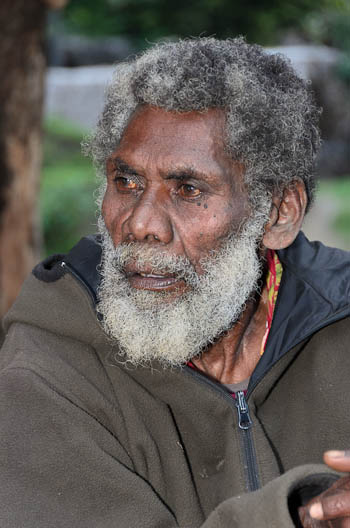
Chief Isaak Wan Nikiau, head of the John Frum Movement
A young woman came to greet us as we slowly walked into the clearing of Namakara, the village at Sulfur Bay. We introduced ourselves and said we would like to see Chief Isaak and his son, Moli. Chief Isaak, leader of the John Frum Movement, came over at once. Moli was already at the nakamal.
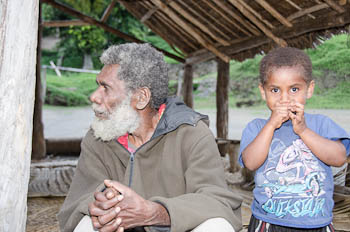
Chief Isaak with his great grandson, and his son, Moli, below
.jpg)
We sat under a large thatched roof unincumbered by walls while Chief Isaak explained the reason he raises the American flag each day in his village. In his broken English he said, and I paraphrase, ‘This is a reminder of our history. The Americans helped us. They freed our leaders from the colonial jails. Their help allowed us the freedom to practice some of our kastom ways, including drinking kava, and insured we could live a traditional lifestyle once again. For this we are grateful.’
Chief Isaak feels a strong tie to the United States and honors the relationship by wearing a military uniform he received on a trip to the US at the parade held each year on February 15. When he realized we were Americans, he disappeared for a few minutes and returned with a big smile and two pictures of himself in uniform.
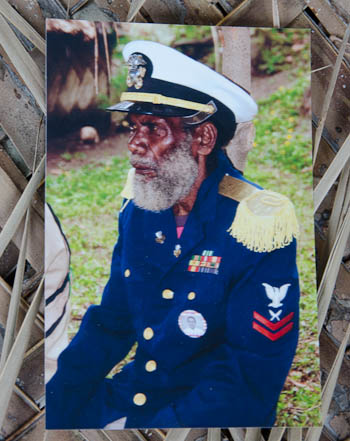
Chief Isaak dresses up for the parade held each year on February 15
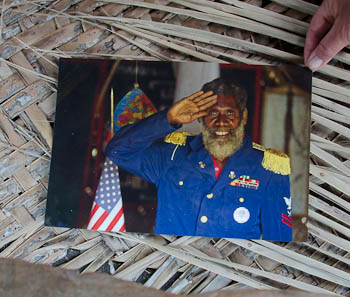
Eventually Moli strolled over to the shelter with a friend and greeted us warmly. Moli insisted I join him at the nakamal and arranged for his daughter-in-law to take Katie to her house.
About 30 men came over to shake my hand and thank me again for taking their photos for the football ID cards. These are necessary to play in the championships. Later Chief Isaak joined us and I had a chance to talk with both of them while we drank kava.
Chief Isaak he told me about their religion and that they have a happy life. John Frum still looks after them and the chief speaks with him often. An interesting comment he made was that civilization on Tanna may be declining slightly. “In many villages they do not even chew the kava root to make the drink, they grind it or prepare it in some other incorrect way.” He does not consider the powdered form found in kava bars at Port Vila to be proper kava.
.jpg)
The two football teams of Sulphur Bay, 51 men in all
.jpg)
There are various stories of John Frum's first appearance. Stanley, chief of the nakamal at Port Resolution, told me about his grandfather, Thomas Nowar, meeting John Frum. So did Thomas Ware, headmaster of the Port Resolution Primary School.
It seems that four or five important chiefs on Tanna were drinking kava together in the 1930s when John Frum appeared to them. One account says it happened at Sulphur Bay in April 1935 while another says at Green Point in 1936. I was told these chiefs were at that first meeting: Tom Meles, Nikiau Moh, Nampas Tommy, Poith Peter and Thomas Nowar.
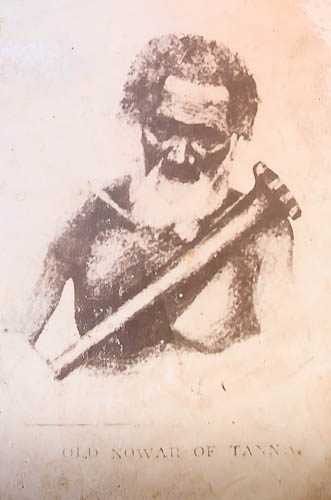
The first missionary to survive the cannibals on Tanna, John Paton, took this picture of Chief Nowar more than 150 years ago. Amazing that it has survived cyclones, floods and volcanic eruptions! I scanned it and printed several copies for Robson, one on his descendants.
Different stories have him appearing as a white man, a black man and even a cat or tiger. Some say he lives in America, others that he lives in the volcano. All the stories have the same message. John Frum told them to stop following the white man’s religions and return to their kastom beliefs. Under religious colonialism, traditional dress, dancing and drinking kava had been banned for a century.

Children of Sulphur Bay wait for the music to begin
The arrival of American troops sent to protect the New Hebrides, as Vanuatu was called before independence in 1980, from being taken over by the Japanese had a big influence on the people of Tanna and the followers of John Frum. Men from Tanna went to Port Vila on Efate to help with the war effort including Stanley’s grandfather. Many more men from the northern islands went to Santo where 50,000 troops were stationed.
Not only had these Americans brought vast amounts of cargo such as guns, tanks, boats, food and medicine, but many had black skin. Before this, everyone was either white and rich or black and poor. The black GIs were kind to the locals and appeared to be treated as equals with the white GIs. They were believed to be descendants of the islanders who had been kidnapped by plantation owners in the past (blackbirding) or John Frum's own detachment of the US army. The Tannese were amazed and thrilled.
The colonial version is that the 'madness' began in 1940, when certain locals began painting their faces white, wearing hats and appearing to other villagers at night, singing about the coming expulsion of the whites and arrival of huge quantities of cargo. One Sunday morning in 1941 the new movement defied the long-standing rules and did not attend the Presbyterian Church services. Instead, a group walked quietly into the store and carefully removed every price tag from each piece of merchandise. The white community was shocked.
A prophet named Manehevi from Sulphur Bay was arrested and tied to a tree for a day by the French colonial administration ‘for encouraging the others.’ Still, John Frum continued to appear. The followers received flags from the Americans which were flown and revered. Witnesses continued to be imprisoned or deported. Thomas told me that four chiefs were put in jail for 17 years. During this period his grandfather, Nagia Sera, kept the flags hidden.
Various reports say that even after American officers tried to explain to the people that John Frum had nothing to do with the American army and if they wanted cargo they were going to have to work for it, the local John Frum followers still believed that Judgment Day was coming soon. Dozens of times across the region, the John Frum followers destroyed all their Western possessions, throwing their hard-earned money into the sea. John Frum would bring new money with a coconut stamped on it.
The movement gradually reinstituted various kastom practices which the administration had no choice but to tolerate. Finally, on February 15th, 1957, an American flag was ceremonially raised in Sulphur Bay and the new religion and their leader, Nakomaka, were officially announced to the outside world.

Each Friday night John Frum followers from all over Tanna gather here to sing songs inspired by John Frum
Today the original John Frum Movement is led by Chief Isaak Wan Nikiau of Sulphur Bay. Chief Isaak still raises the American flag, among others, each morning at 8 am and takes them down at 4 PM.
Groups from all over Tanna gather under the shelter in Sulphur Bay each Friday night to sing new songs about the kastom lifestyle inspired by John Frum. The men cluster closely together crossed-legged on mats playing their guitars and singing in their local languages. Women and children huddle close behind singing and clapping. People dance outside in the dark. It is all very solemn.
A gong sounds to signal the end of each performance. Only the white onlookers sitting together clap. They arrive after dark from various points on the island via worn 4WD trucks.
The night we were there, the first group to perform was from Port Resolution. Charlie was one of the musicians. We met when I repaired his sister's sewing machine. When his group finished playing he came over and shook our hands very seriously. Perhaps we are biased; we liked their songs best. The singing and dancing goes on through the night and ends the next morning.
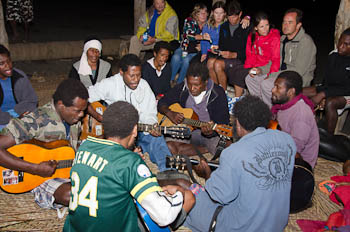
Yachties look on as the group from Port Resolution plays, Katie sits on the far side with some Ni-Vans

Moli said that he will follow his father as the leader of the John Frum Movement and will continue to raise the flags each morning and take them down each evening.
Later Moli came to the house where Katie and I were staying. I gave him two gifts to show our gratitude. He was pleased to receive the American flag that hung from Tenaya’s stern, but he was thrilled with the Red Cross hand crank flashlight. The village had one rechargeable solar light which was brought into the hut made of pandanus leaves for our convenience. But, when the time came for the weekly songfest, it was taken to the gathering spot. In a village with no electricity and no source of batteries, a hand crank light will be most useful.
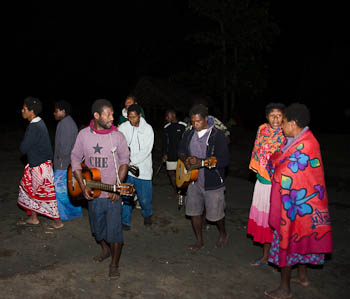
Time to play!
As what seems to happen to most religions, John Frum had a major split in 2000. During 1997 Fred Nase, from the village of Ienkah, was working on a Taiwanese fishing boat when a light and voice from the sky spoke to him. He was told that the waters of Lake Siwi, a large lake at the base of Mount Yasur, represented their kastom beliefs. One day soon it would flow to the sea which represents western influences. This would prove their need to keep their kastom beliefs but also accept Christianity.
Fred went back to Tanna and explained this to the people of Sulphur Bay but they would not listen. He went to the next village where they did listen. Although the lake had been there for hundreds of years, the villagers heeded the warning and moved to higher ground. After 30 days and nights of rain the lake breached and all the water flowed into the sea. Nobody drowned. Now the area is just a continuation of the vast ash plain. Fred Nase became Prophet Fred.
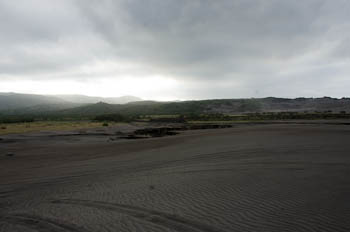
The remains of Lake Siwi
Prophet Fred believes that John Frum was not telling the people to await his return but to wait for the second coming of Christ. He named the new religion Unity Movement Join in Christ or, Unity in Christ. Most people simply call it Unity. Prophet Fred stressed the importance of unity between the John Frum Movement and the Presbyterian Church. The Presbyterians have apologized for wrong doings in the past and now tell Unity it is okay to be both Presbyterian and kastom. Thomas told me that the central Presbyterian Church is helping to finance local Unity churches and helping with evangelist work including locating and killing poison stones, healing the sick and controlling the weather.
When I first asked Thomas about John Frum his face lit up. He was surprised that I was interested and said I was the first white person to ask about it. Then he invited me to his house where we talked for hours and he pulled out a typed paper he had written on the subject. I scanned it on Tenaya and make a few extra copies for him.
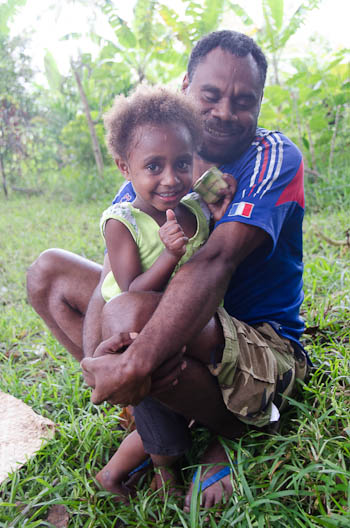
Thomas Ware of Unity is the headmaster of Port Resolution Primary School
Unity has moved their John Frum Day from February 15 to December 15 and their ‘sabbath’ from Friday night to Wednesday afternoon. Thomas Ware explained that there are too many problems with night time celebrations, although after attending two Friday evenings in Sulphur Bay, I can’t image what problems he had in mind.
Unlike alcohol, kava ingestion encourages the body and mind to sit quietly and contentedly. Unity still believes there is a special connection to the USA and still raises the flags. New songs are still inspired by John Frum, but in addition to Kastom and the future, there is now talk of Jesus Christ.
Thomas, a leader of Unity, told me that out of the 28 largest nakamals, only a few still follow Chief Isaak He said, “as we open more churches around Tanna, nearly all the John Frum followers are joining. Our goal is to make everyone happy…that is Unity!” Prophet Fred died last year but Unity seems to be going strong.
When asked about Unity, Stanley, who is Kastom and a John Frum follower said, “They are Presbyterians” with a smile. I am inclined to agree.
.jpg)
Walking across the ash plain below Mount Yasur
David Attenborough, visited Sulphur Bay in 1960 for his Quest in Paradise TV series, and dismissed John Frum followers as a "sinister cult", "pathetically childish", and no more than an "act of defiance towards the mission". They could say things like that 50 years ago. But today we are so politically correct that we go out of our way to never say anything that could offend any religion. We say Happy Holidays to make sure we include everyone. We are careful to respect all the religions, all but the John Frum Movement.
In February 2006 Smithsonian magazine printed: “South Pacific villagers worship a mysterious American they call John Frum believing he’ll one day shower their remote island with riches. The John Frum Movement has endured based on a worship of an American god no sober man has ever seen.” Can you imagine them saying the same thing about the Mormons?
The current Lonely Planet Guide to Vanuatu states, “Flags are raised each evening to this god of their collective imagination.” And if the Lonely Planet Guide to Rome were to write, “The Catholics celebrate Mass to this god of their collective imagination,” well, can you envision the response?
.jpg)
All the John Frum followers we've met are incredibly nice
After spending time with many members of the John Frum Movement my respect for them is higher than for many people of other mainstream religions.
While they hold strong beliefs, they are humble and live harmoniously with people of many different religions. Vanuatu’s religious profile is truly unique as religious freedom is written into their constitution and tolerance really does prevail. In a worldwide survey, Vanuatu has come in first as the happiest people on Earth twice in the last five years. And perhaps the John Frum followers just might be the happiest people in Vanuatu.
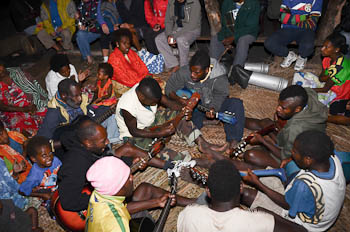
Click here to listen to a John Frum song
For an entertaining and purely fictional account of a cargo cult, check out Christopher Moore’s Island of the Sequined Love Nun. For an equally imaginary but thought-provoking view of Christianity, read his book, Lamb. It fills in the gaps of Jesus’ life between the ages of 3 and 30. Both are hilarious!
Go to September 2012 Part One - Port Vila, Efate, Vanuatu